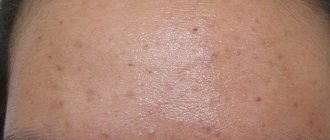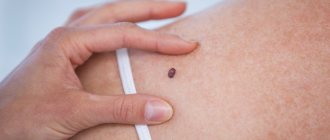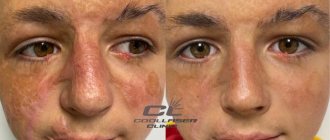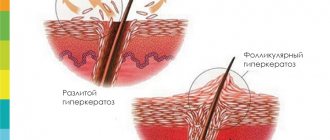A scar is a formation represented by connective tissue that forms at the site of skin damage (wound).
Scars are formed as a result of damage to the skin due to various etiological factors:
- mechanical injury,
- surgery,
- thermal burn,
- chemical burn.
The nature of the damaging agent, the degree of damage, anatomical location, duration of injury, as well as individual characteristics of wound healing determine the variety of types and forms of scars. The course of the scar process, in turn, dictates the need to use one or another treatment tactic that is optimal for each specific case, in order to achieve the best possible aesthetic result.
Types of scars
Among the types of scars, there are several main, most common:
Hypertrophic scarA hypertrophic scar is formed as a result of excessive filling of the wound defect with connective tissue; these scars are dense and protrude to varying degrees above the level of the adjacent skin, which makes them noticeable to others. The prerequisites for the formation of hypertrophic scars are the volume and depth of damaged tissue; course of the wound process with inflammatory and purulent-inflammatory manifestations; localization of the wound in the chest and shoulder girdle area, as well as the flexor and extension surfaces of the joint area; individual tendency to excessive scarring. | |
Normotrophic scarA normotrophic scar is formed when the course of the scar process is favorable, without the formation of a significant amount of excess connective tissue. However, this type of scar is characterized by an uneven surface of the skin over the scar and a pronounced border with unchanged skin. | |
Atrophic scarAn atrophic scar is formed as a result of insufficient volume of connective tissue compared to the volume of the wound defect. These scars “sink” below the level of the surrounding unchanged skin and have clearly defined boundaries. This type of scars is most often found in the forehead and dorsum of the nose. This type of scar includes stretch marks (striae). |
Keloid scarsKeloid scars are characterized by the fact that they significantly exceed the original wound defect in volume and area, and also continue to increase in size for a long time. This type of scar is difficult to treat, both therapeutically and surgically. |
Without surgery
Conservative treatment involves the following methods:
· Ointments, plasters. There are various medications that are effective in the early stages of the appearance of a scar - immediately after the wound has healed. They will not remove the scar, but will make it a little less noticeable.
· Peelings. It involves exfoliating dead skin cells and stimulating the regeneration of new cells. The technique only works with small scars, because... affects the upper layers of the skin.
· Mesotherapy. A preparation enriched with vitamins, amino acids and hyaluronic acid is injected into the damaged area. These stimulate the formation of new skin cells, as a result of which the scar softens.
· Photorejuvenation. The skin is exposed to light pulses that stimulate metabolic processes in the dermis. A set of procedures makes the scar less noticeable.
· Laser skin resurfacing. The problem area is treated with a laser, as a result of which microchannels are formed in the skin. They stimulate the dermis' production of its own collagen. The laser also destroys dead cells.
· Contour plastic surgery. Helps get rid of atrophic scars. Filler with hyaluronic acid is injected into the damaged areas, as a result of which the skin surface is smoothed and the scar is reduced.
· Cryodestruction. The scar is exposed to low temperatures, as a result of which pathological tissues are destroyed.
Scar treatment
If there is an immature form of the scar, physiotherapeutic treatment, local application treatment and injection drug treatment are carried out, aimed at reducing scar hypertrophy and speeding up their maturation.
An example of preparation for laser dermabrasion surgery of a patient with an immature hypertrophic scar:
If there is a mature form of the scar, it is possible to perform laser dermabrasion surgery. This operation is performed under local application anesthesia using a high-energy CO2 laser, which allows for ablation (evaporation) of excess amounts of scar tissue, which subsequently leads to smoothing of the skin texture.
Stages of healing
Stage I - inflammation and epithelization (7-10 days after injury). Post-traumatic inflammation of the skin gradually decreases. The edges of the wound are connected to each other by fragile granulation tissue; there is no scar as such yet. This period is very important for the formation of a thin and elastic scar in the future - it is important to prevent suppuration and divergence of the edges of the wound. For these purposes, surgeons apply cosmetic fixing sutures with a special atraumatic suture material (very thin threads with a round cross-section) and prescribe topical anti-inflammatory drugs for daily dressings. It is recommended to limit physical activity, since frequent movements of muscles, tendons and ligaments under the wound can cause separation of the edges of the wound.
Stage II - formation of a “young” scar (10-30 days after injury). Collagen and elastin fibers begin to form in the granulation tissue. Increased blood supply to the area of injury remains - the scar is bright pink. Until the fibers have matured, the scar remains easily extensible, so repeated external trauma and excessive physical effort should not be allowed during this period.
Stage III - formation of a “mature” scar (30-90 days after injury). The number of collagen and elastin fibers increases significantly, the fibers begin to line up in specifically directed bundles. The number of vessels decreases - the scar thickens and becomes pale. Physical activity is allowed to the usual extent. At this stage, unfavorable conditions (see above) lead to the formation of hypertrophic and keloid scars.
Stage IV - final transformation of the scar (4-12 months after injury). Scar tissue slowly matures - blood vessels completely disappear from them, collagen fibers line up along the lines of greatest tension. The scar becomes light and dense. Already at the beginning of this period, the surgeon can finally assess the condition of the skin scar and determine the type of surgical correction.
Zolotov Sergey Alexandrovich
- Candidate of Medical Sciences, surgeon, specialist in laser surgery.
- From 2003 to 2009 completed training at the State Budgetary Educational Institution of Higher Professional Education "Russian National Research Medical University" named after. N.I.Pirogov Ministry of Health of Russia.
- From 2009 to 2011, he completed his residency at the Moscow State Budgetary Healthcare Institution, Research Institute of Emergency Pediatric Surgery and Traumatology, specializing in Pediatric Surgery.
- In 2011, he completed training under the program of additional professional education of doctors in laser medicine at the State Scientific Center for Laser Medicine of the Federal Medical and Biological Agency of Russia. From 2011 to 2014, he studied full-time graduate school at the Moscow State Budgetary Healthcare Institution Research Institute of Emergency Pediatric Surgery and Traumatology.
He has extensive experience in removing various benign formations of the skin and subcutaneous tissue using laser surgical methods.
More than 5 years of experience in surgery.
Symptoms of a keloid scar
At the beginning of the formation of a keloid scar, the symptoms are similar to those of a hypertrophic scar. But as the keloid develops, there is no longer any doubt about the diagnosis.
Keloid scars are characterized by the following symptoms:
- the surface is often shiny and smooth, but sometimes lobular and bumpy;
- rise significantly above the skin (more than 5 mm);
- very dense to the touch (reminiscent of rubber);
- the color and intensity of the color can be varied - from bright pink to bluish (the reason for this diversity lies in the number of blood vessels that supply the scar);
- the shape can be different, sometimes even bizarre (does not correspond to the tissue trauma that occurred). This is due to the growth of the keloid process along the skin stretch lines;
- the size is usually larger than the previous injury;
- the skin in the scar area is tense, small vessels may be dilated;
- almost everyone has itching in the scar area;
- many experience pain, numbness and increased sensitivity of the scar (even when touching clothing);
- do not disappear on their own over time;
- If removed surgically, there is a high probability that keloids will begin to appear again.
In addition, keloid scars that grow over large areas can limit movement. This is especially common after burns.
In the presence of such an aesthetic problem, complexes often form, and due to constant itching and discomfort, even psychological disorders.
"before" and "after" photos
How to remove keloid scars at home
You can find a lot of information on the Internet about how to get rid of keloid scars without doctor intervention. Here are the most popular methods:
- regular use of moisturizing creams;
- cream with onion extract for healing scars;
- lemon juice to lighten scars;
- compresses with castor oil;
- applying aloe;
- compresses with green tea;
- rubbing in liquid vitamin E and D;
- lavender oil;
- a mixture of St. John's wort and castor oil;
- Apple vinegar;
- manuka honey;
- Arnebia grass.
There are many more traditional ways to remove scars than those listed. But their effectiveness has not been proven. The body may react negatively to such methods, such as an allergic reaction. Moreover, trying to remove the keloid can make the situation worse. After all, keloid scars form even after trauma at the microscopic level.
Treatment of keloid scars is a complex problem that requires an integrated approach. Therefore, you need to contact proven specialists who use reliable techniques.
Price list for medical services of the laser surgery department
Consultation
| Name | Cost in rub. |
| Initial consultation | 2 000 |
Research
| Name | Cost in rub. |
| Cytological examination | 500 |
| Histological examination | 2 800 |
Anesthesia
| Name | Cost in rub. |
| Application anesthesia | 500 |
| Infiltration anesthesia | 500 |
| Conduction anesthesia | 1 500 |
Bandages
| Name | Cost in rub. |
| Adhesive bandage | 300 |
| Aseptic dressing | 500 |
| Bandage with medicines | 1 000 |
Removal of formations using laser radiation
| Anatomical zone | Cost in rub. for 1mm in maximum diameter |
| Scalp | 500 |
| Hands, forearms, feet, legs | 500 |
| Neck, chest, abdomen, back, armpits, shoulders, hips, crotch | 600 |
| Forehead, temporal region, ears, postauricular region | 600 |
| Eyebrows, nose, nasolabial triangle, chin, cheeks, cheekbones, red border of lips | 700 |
| Lower upper eyelids | 850 |
| Ciliary edge of the eyelids | 1 000 |
| External genitalia - single elements* *per 1 mm. 600 rub. | 1 000 |
Removal of papillomas with a diameter of up to 2.0 mm
| Name | Cost in rub. for a unit |
| Neck, chest, abdomen, back, armpits, shoulders, hips, crotch | 300 |
| Lower upper eyelids | 500 |
| Ciliary edge of the eyelids | 1 000 |
Scar treatment
| Name | Cost in rub. |
| Drug injection into the scar | 1 200 |
| Laser dermabrasion (resurfacing) per cm² | 1 200 |
Removal of vascular formations using laser radiation*
| Name | Cost in rub. |
| Photodestruction of the vessels of the wings of the nose | from 5 000 |
| Photodestruction of cheek vessels | from 10 000 |
*exact cost depends on capillary density, repeated stage of vessel destruction minus 30%
Treatment of ingrown toenails using laser radiation
| Name | Cost in rub. |
| Marginal resection of the nail plate | 6 000 |
| Removal of hypergranulations | 1 900 |
| Nail plate removal | 3 500 |
| Complex plastic surgery for ingrown toenails | 8 500 |
Removal of lipoma, atheroma
| Name | Cost in rub. |
| Lipoma removal | 18 000 |
| Removal of atheroma up to 5 mm | 6 000 |
| Removal of atheroma from 5 to 10 mm | 12 000 |
| Removal of atheroma more than 10 mm | 18 000 |
First aid for skin
Treatment depends on the type of scar, but moisturizing is a universal aid in combating redness, swelling and enlargement. “First of all, a fresh scar needs to be well moisturized - do this at least four times a day. Another tip: use a special silicone gel or wipes , such as Dermatix or MepiDex,” says Dr. Funston. The silicone composition not only maintains the water balance of damaged skin, but also protects it from any harmful environmental influences, and cosmetics can also be applied on top of it. There are other healing agents: for example, Kontraktubeks is easy to buy in Russian pharmacies.
It is also, of course, important to avoid direct sunlight. “Under no circumstances should the scar be exposed to the sun, otherwise there will be more pigment on the affected area than on the surrounding skin. Use sunscreen with SPF 50,” says Dr. Funston.











